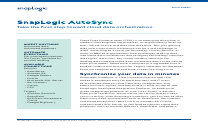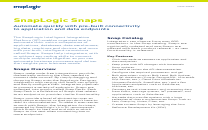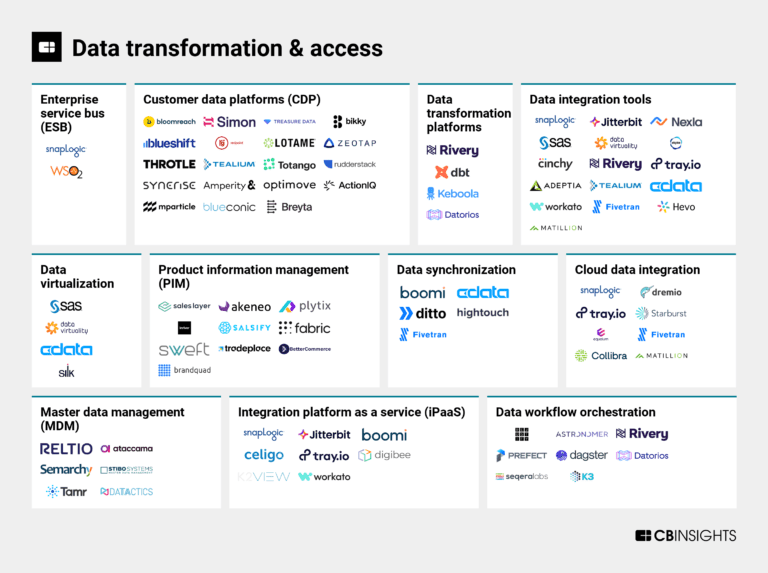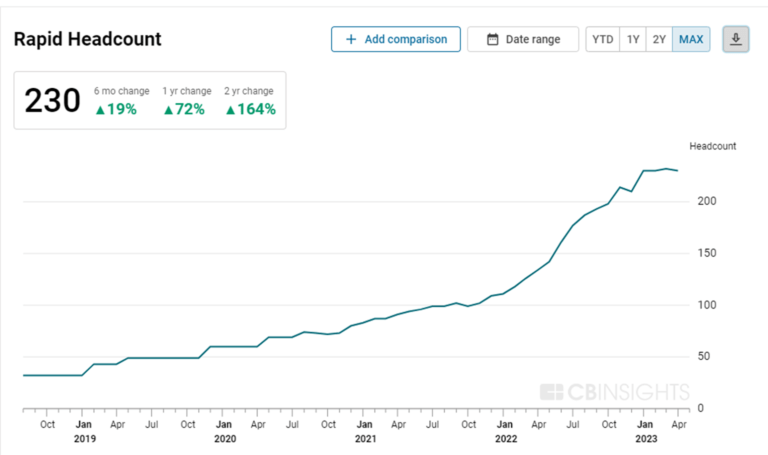
SnapLogic
Founded Year
2006Stage
Series H | AliveTotal Raised
$397.86MValuation
$0000Last Raised
$165M | 3 yrs agoRevenue
$0000Mosaic Score The Mosaic Score is an algorithm that measures the overall financial health and market potential of private companies.
-106 points in the past 30 days
About SnapLogic
SnapLogic specializes in enterprise integration and offers a cloud-based platform for connecting applications, data, and devices. Its main offerings include an iPaaS solution that facilitates data and application integration, as well as API management, all enhanced by artificial intelligence to streamline business processes. SnapLogic primarily serves sectors such as manufacturing, retail, financial services, and higher education with their automation and integration solutions. SnapLogic was formerly known as Brown Fox Software. It was founded in 2006 and is based in San Mateo, California.
Loading...
SnapLogic's Product Videos


ESPs containing SnapLogic
The ESP matrix leverages data and analyst insight to identify and rank leading companies in a given technology landscape.
The data integration tools market includes a wide range of solutions that enable the creation of a unified data platform, through the extraction, transformation, and loading (ETL) of data from disparate sources, including legacy systems and modern cloud systems. The market offers alternatives to traditional data architecture, such as hubs and lakes, and provides automated data protection and impro…
SnapLogic named as Challenger among 15 other companies, including Databricks, IBM, and Microsoft Azure.
SnapLogic's Products & Differentiators
SnapLogic Intelligent iPaaS
Intelligent iPaaS
Loading...
Research containing SnapLogic
Get data-driven expert analysis from the CB Insights Intelligence Unit.
CB Insights Intelligence Analysts have mentioned SnapLogic in 2 CB Insights research briefs, most recently on Aug 4, 2023.

Aug 4, 2023
The data transformation & access market mapExpert Collections containing SnapLogic
Expert Collections are analyst-curated lists that highlight the companies you need to know in the most important technology spaces.
SnapLogic is included in 2 Expert Collections, including Unicorns- Billion Dollar Startups.
Unicorns- Billion Dollar Startups
1,257 items
Tech IPO Pipeline
282 items
Track and capture company information and workflow.
SnapLogic Patents
SnapLogic has filed 1 patent.

Application Date | Grant Date | Title | Related Topics | Status |
|---|---|---|---|---|
9/21/2012 | Data types, Data management, Network protocols, Serial buses, Industrial computing | Application |
Application Date | 9/21/2012 |
|---|---|
Grant Date | |
Title | |
Related Topics | Data types, Data management, Network protocols, Serial buses, Industrial computing |
Status | Application |
Latest SnapLogic News
Dec 11, 2024
Unite.AI Published Table Of Contents Nitin Singhal is a seasoned technology and product leader with over 25 years of experience in the industry. He currently serves as the Vice President of Engineering at SnapLogic, focusing on responsible integration of applications and systems, leveraging Agentic architecture to unlock data potential for a global audience. Before his role at SnapLogic, Nitin was the Senior Director of Engineering at Twitter, where he led the Data Management and Privacy Infrastructure engineering functions. His work involved establishing data governance practices during a critical period for the company, ensuring responsible data usage and compliance with privacy regulations. Nitin has also held various engineering and product leadership positions at prominent organizations, including Visa, PayPal, and JPMorgan Chase, where he contributed to significant advancements in data strategy and management. SnapLogic is an AI-powered integration platform that streamlines data and application workflows with no-code tools and over 1,000 pre-built connectors. It supports ETL/ELT, automation, API management, and secure deployments across cloud, on-premises, and hybrid environments. Features like SnapGPT and AutoSync enhance efficiency, enabling organizations to integrate and orchestrate processes seamlessly. You have nearly 25 years of experience driving technology innovation. What first inspired you to pursue a career focused on using tech to solve complex problems, and how has that passion evolved with the rise of AI? From the beginning of my career, I was captivated by the challenge of solving puzzles and the logical beauty of mathematics. This fascination naturally led me to explore how technology could address complex, real-world problems. Early in my career, I was inspired by the potential of technology to tackle issues like transaction fraud detection and data privacy risks. My passion has only deepened as AI has evolved, particularly with the advent of Generative AI. I've witnessed AI's transformative impact, from empowering farmers with crop insights via smartphones to enabling everyday users, like my father, to navigate tasks such as tax filing easily. The democratization of AI technology excites me, allowing us to make a positive difference in people's lives. This ongoing journey fuels my commitment to advancing AI in ways that are not only innovative and efficient but also safe, responsible, and accessible to all. What are the biggest risks businesses face when relying on outdated technology in the age of advanced AI? Relying on outdated technology poses significant risks that can jeopardize a business's future. Obsolete systems, particularly legacy infrastructures, lead to crippling inefficiencies and prevent organizations from harnessing AI for high-value tasks. These outdated technologies struggle with data accessibility and integration, creating costly operational bottlenecks that hinder automation and innovation. The hidden costs of maintaining such systems add up, draining resources while making it challenging to attract top talent who prefer modern tech environments. As companies become trapped in a cycle of stagnation, they miss out on progressive growth opportunities and risk being outpaced by more agile competitors. The choice is clear: evolve like the iPhone or face the fate of BlackBerry. How do legacy systems struggle to meet the demands of modern AI applications, particularly regarding energy, demand, and infrastructure? Legacy systems face significant challenges in meeting the demands of modern AI applications due to their inherent limitations. These outdated infrastructures need more data processing capabilities, scalability, and flexibility for AI's intensive computational needs. They often create data silos and bottlenecks, hindering real-time, interconnected data handling crucial for AI-driven insights. This incompatibility impedes the implementation of advanced AI technologies and leads to inefficient resource usage, increased energy consumption, and potential system failures. Consequently, businesses relying on legacy systems struggle to fully leverage AI's potential in critical areas such as precision targeting, payroll reconciliation, and fraud detection, ultimately limiting their competitive edge in an AI-driven landscape. What are the “hidden” costs of complacency for companies that hesitate to modernize their systems? Relying on outdated technology means businesses depend on manual processes and siloed data, leading to increased costs and diminished productivity. Over time, this inefficiency compounds, resulting in missed opportunities and a significant loss of competitive edge as more agile competitors adopt AI solutions. Furthermore, employee potential is squandered on repetitive tasks instead of strategic work, causing frustration and potentially higher turnover rates. As rivals leverage AI for greater efficiency and innovation, companies that delay modernization risk falling further behind, ultimately jeopardizing their market position and long-term viability in an increasingly digital landscape. Organizations must discern between legitimate concerns surrounding AI adoption and instances where human insecurities give rise to misleading narratives. How can businesses evaluate if they’re falling behind in terms of infrastructure readiness for AI? Businesses can evaluate their AI readiness by assessing whether their current systems can integrate with modern AI tools and scale to meet increasing data demands. If they struggle to process large datasets efficiently, leverage cloud solutions, or support automation, it's a clear sign they may be falling behind. Additionally, companies should examine if legacy systems create bottlenecks or require excessive manual intervention, hindering productivity. Key indicators of lagging infrastructure include data silos, inadequate real-time analytics, insufficient computing power for complex algorithms, and challenges in attracting AI talent. Ultimately, organizations constantly playing catch-up with AI capabilities risk losing their competitive edge in an increasingly digital landscape. I will also emphasize that cutting-edge observability, security, and privacy protection techniques following composable architecture are critical for seamless and responsible AI readiness. What are some practical steps organizations can take today to future-proof their systems for AI innovations? The first step is to evaluate the current tech stack and look for areas where AI can be integrated. Organizations should prioritize scalable cloud solutions that support AI-driven automation and make it easy to incorporate new technologies. In particular, low-code platforms can help businesses with limited resources quickly deploy AI agents without needing deep technical expertise. Enterprises should also ensure that they have flexible, cloud-based infrastructure that can scale as needed to support future AI applications. In your opinion, which industries stand to gain the most by rapidly adopting AI and upgrading legacy systems? Industries that rely on data-driven decision-making and repetitive tasks stand to benefit the most. For instance, in the financial services sector, AI can automate tasks like customer support, fraud detection, and loan approvals, streamlining operations and enhancing the customer experience. Similarly, sales and customer service departments can see a significant productivity boost by using AI to handle routine queries or process leads more efficiently. Companies in healthcare, manufacturing, and retail industries can also benefit significantly from AI, especially as AI tools can help optimize supply chains, predict demand, and automate administrative work. Rather than performing these repetitive tasks, domain experts can focus on strategic work, creating a high return on AI investment. How does SnapLogic’s platform specifically support companies in replacing fragmented, legacy infrastructure with AI-driven solutions? SnapLogic's platform empowers businesses to unify and automate workflows across data and applications, bridging legacy systems with modern, AI-ready infrastructure. By seamlessly connecting fragmented data sources and simplifying integration across cloud and on-premises environments, SnapLogic accelerates the transition to a unified system where AI can deliver immediate value. The platform's low-code interface, including tools like AgentCreator and SnapGPT, enables companies to rapidly deploy AI-driven solutions for various use cases, from automating customer interactions to enhancing financial reporting and marketing effectiveness. SnapLogic's IRIS AI technology provides intelligent recommendations for building data pipelines, significantly reducing the complexity of integration tasks and making the platform accessible to users with varying levels of technical expertise. SnapLogic prioritizes data governance, compliance, and security in AI initiatives. With features like end-to-end encryption, comprehensive logging, and agent action previews, enterprises can confidently scale their AI projects. The recent launch of an integration catalog and data lineage tools provides essential context to protect sensitive data from leakage during ingress and egress. Additionally, SnapLogic offers integration capabilities into modern systems in a composable manner, driving business objectives while providing flexible solutions to address cost, compliance, and maintenance challenges. What unique challenges have you encountered at SnapLogic in developing products that bridge legacy and modern AI-integrated systems? One unique challenge in bridging legacy and modern AI-integrated systems has been ensuring that our SnapLogic Platform can accommodate the rigidity of older systems while still supporting the flexibility and scalability required for AI applications. Another challenge has been creating a platform accessible to technical and non-technical users, which requires balancing advanced functionality with ease of use. As an enterprise SAAS company, SnapLogic balances the unique and generic needs of 100s of our customers across different industries while continuously evolving the platform to adopt new and modern technologies in a flexible, responsible, and backward-compatible manner To address this, we developed pre-built connectors that seamlessly integrate data across old and new platforms. With SnapLogic AgentCreator, we’ve also enabled organizations to deploy AI agents that automate tasks, make real-time decisions, and adapt within existing workflows. Could you elaborate on SnapLogic’s “Generative Integration” and how it enables seamless AI-driven automation in enterprise environments? SnapLogic’s Generative Integration is a cutting-edge feature of SnapLogic's platform that utilizes generative AI and large language models (LLMs) to streamline and automate the creation of integration pipelines and workflows. This innovative approach enables businesses to seamlessly connect systems, applications, and data sources, facilitating a smoother transition to AI-driven environments. By interpreting natural language prompts, Generative Integration empowers even non-technical users to develop, customize, and deploy integrations with ease quickly. This democratization of integration accelerates digital transformation and reduces reliance on extensive coding expertise, allowing enterprises to focus on strategic initiatives and enhance operational efficiency. Additionally, SnapLogic offers immense flexibility by allowing customers to utilize any public LLM models tailored to their specific needs, ensuring that organizations can leverage the best tools available while maintaining robust governance and compliance standards. Thank you for the great interview, readers who wish to learn more should visit SnapLogic .
SnapLogic Frequently Asked Questions (FAQ)
When was SnapLogic founded?
SnapLogic was founded in 2006.
Where is SnapLogic's headquarters?
SnapLogic's headquarters is located at 1825 South Grant Street, San Mateo.
What is SnapLogic's latest funding round?
SnapLogic's latest funding round is Series H.
How much did SnapLogic raise?
SnapLogic raised a total of $397.86M.
Who are the investors of SnapLogic?
Investors of SnapLogic include Sixth Street Growth, Arrowroot Capital, Golub Capital, Andreessen Horowitz, Ignition Partners and 15 more.
Who are SnapLogic's competitors?
Competitors of SnapLogic include Apideck, Digibee, Adeptia, Workato, Conektto and 7 more.
What products does SnapLogic offer?
SnapLogic's products include SnapLogic Intelligent iPaaS.
Who are SnapLogic's customers?
Customers of SnapLogic include Adobe, Box, WD-40, aramark and Bristol Meyers Squib.
Loading...
Compare SnapLogic to Competitors

Boomi focuses on providing intelligent connectivity and automation solutions within the integration platform as a service (iPaaS) industry. The company offers a suite of services, including application and data integration, API management, and master data synchronization, to facilitate digital transformation for businesses. Boomi primarily serves sectors such as healthcare, life sciences, manufacturing, financial services, retail, the public sector, and higher education. It was founded in 2000 and is based in Conshohocken, Pennsylvania.

Jitterbit focuses on providing data integration solutions and low-code application development within the technology sector. Its main offerings include a platform for connecting systems, automating workflows, and creating applications with a low-code approach. Jitterbit's products and services are designed to facilitate seamless integration and automation for businesses across various industries. It was founded in 2003 and is based in Alameda, California.

Workato specializes in artificial intelligence (AI)-powered enterprise automation. The company offers a platform that enables businesses to automate their processes by integrating their applications, data, and experiences, all in a low-code, no-code environment, primarily serving sectors such as information technology, human resources, sales, marketing, finance, and support. It was founded in 2013 and is based in Mountain View, California.

Actian is a company focused on providing data platform solutions across various industries. Their main offerings include a unified platform for data management, analytics, and integration, as well as a suite of databases designed for different computing needs, such as NoSQL, relational, and embedded systems. Actian's products cater to sectors that require robust data processing, storage, and analysis capabilities. It is based in Palo Alto, California.

TIBCO Software focuses on infrastructure and business intelligence software. It offers products such as TIBCO Cloud integration, TIBCO Cloud API management, TIBCO BusinessWorks, TIBCO BusinessConnect, and more. The company caters to banking, credit unions, energy, government, healthcare, insurance, and more. TIBCO Software was founded in 1997 and is based in Palo Alto, California.
Sensedia provides API management and integration solutions across various industries. The company offers services, including API lifecycle management, integration flow creation, service mesh development, and governance to support digital experiences, partner ecosystems, and legacy modernization. Sensedia serves sectors such as artificial intelligence, banking, e-commerce, and insurance. It was founded in 2007 and is based in Campinas, Brazil.
Loading...
